Abstract
We studied the penetration of ampicillin-sulbactam in the alveolar lining fluid (ALF) of eight patients after intravenous administration of 2,000 mg of ampicillin and 1,000 mg of sulbactam three times daily over 30 min. Bronchoalveolar lavage was performed on day 3, 30 min after the end of the morning drug administration. The mean penetration ratios (i.e., the ratios of the concentrations in ALF versus those in serum) were 53% (standard error, 12%) and 61% (standard error 31%) for ampicillin and sulbactam, respectively. The concentration ratio of ampicillin versus sulbactam in serum was not significantly different from that in ALF. From a pharmacokinetic point of view, ampicillin-sulbactam is a good choice for treatment of infectious exacerbation of chronic obstructive pulmonary disease and community-acquired bacterial pneumonia, since the concentrations of both drugs in ALF exceed the MICs for the respiratory pathogens responsible.
Full text
PDF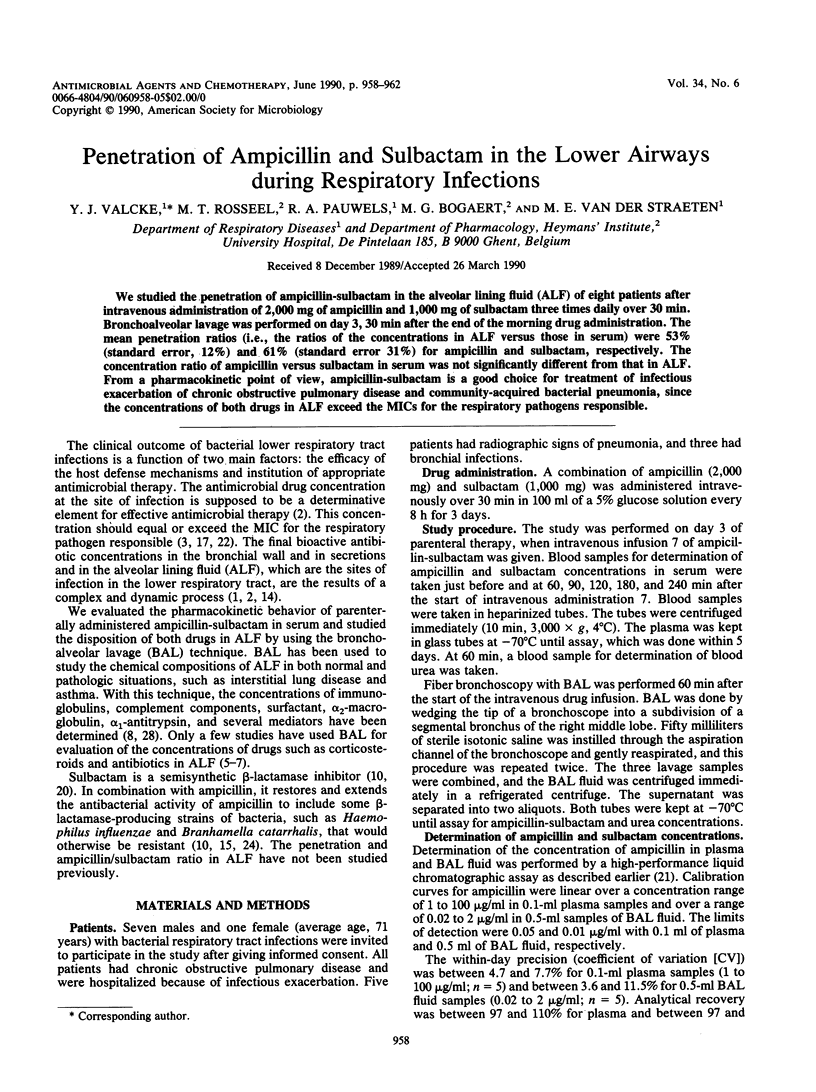
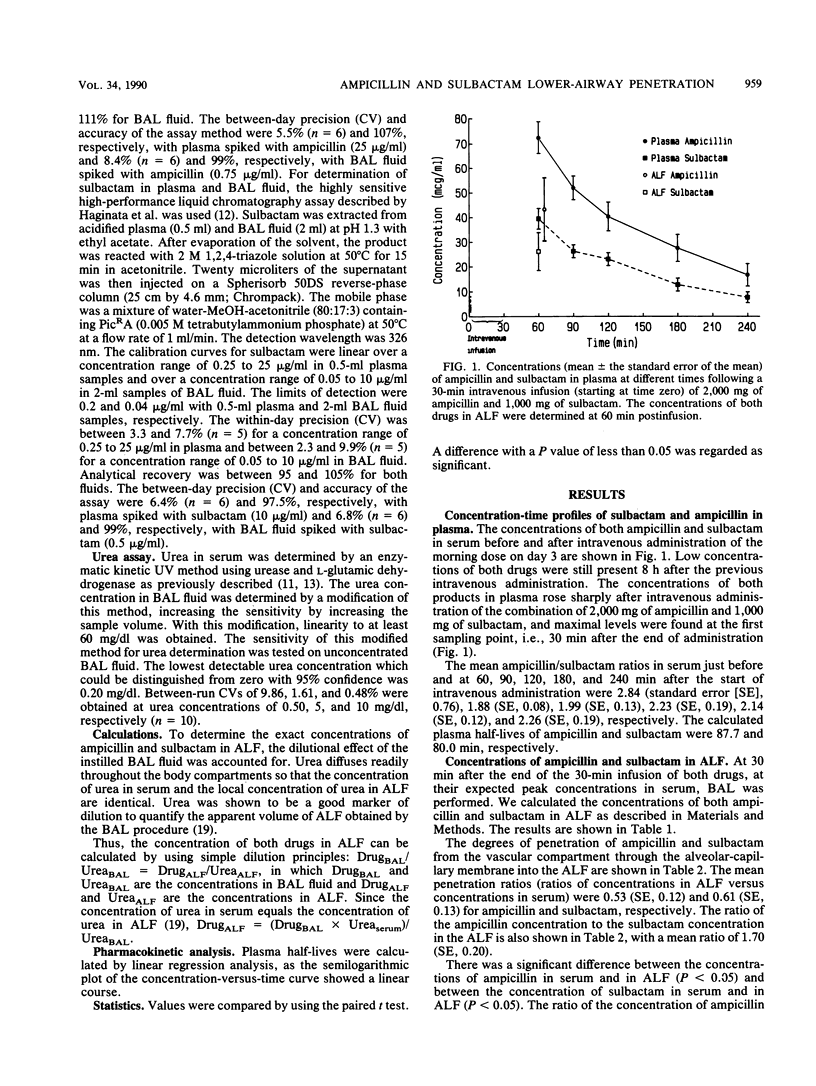
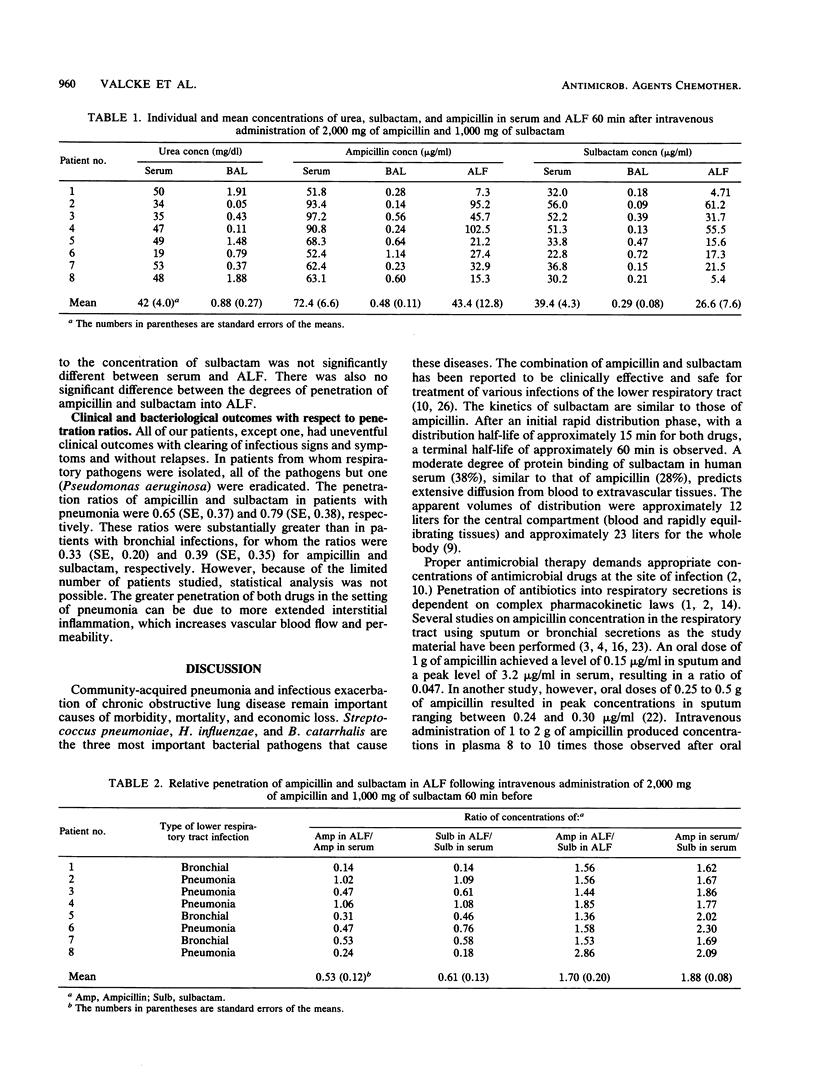
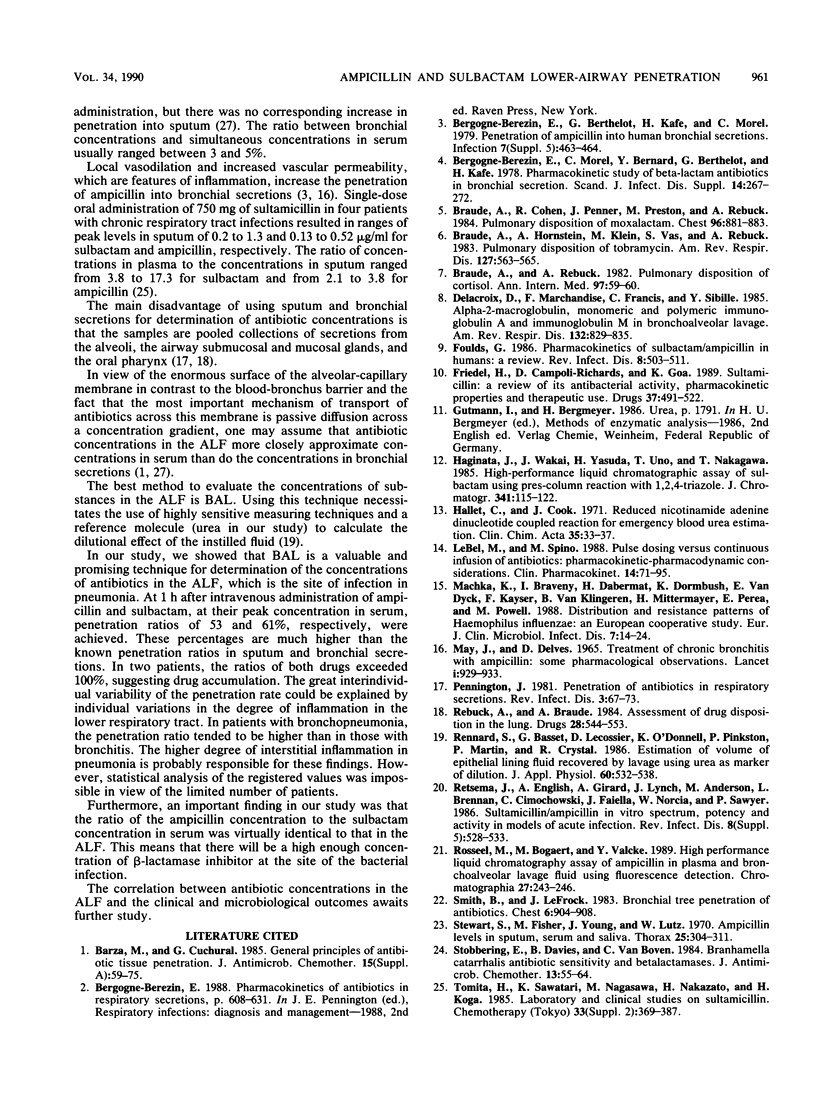
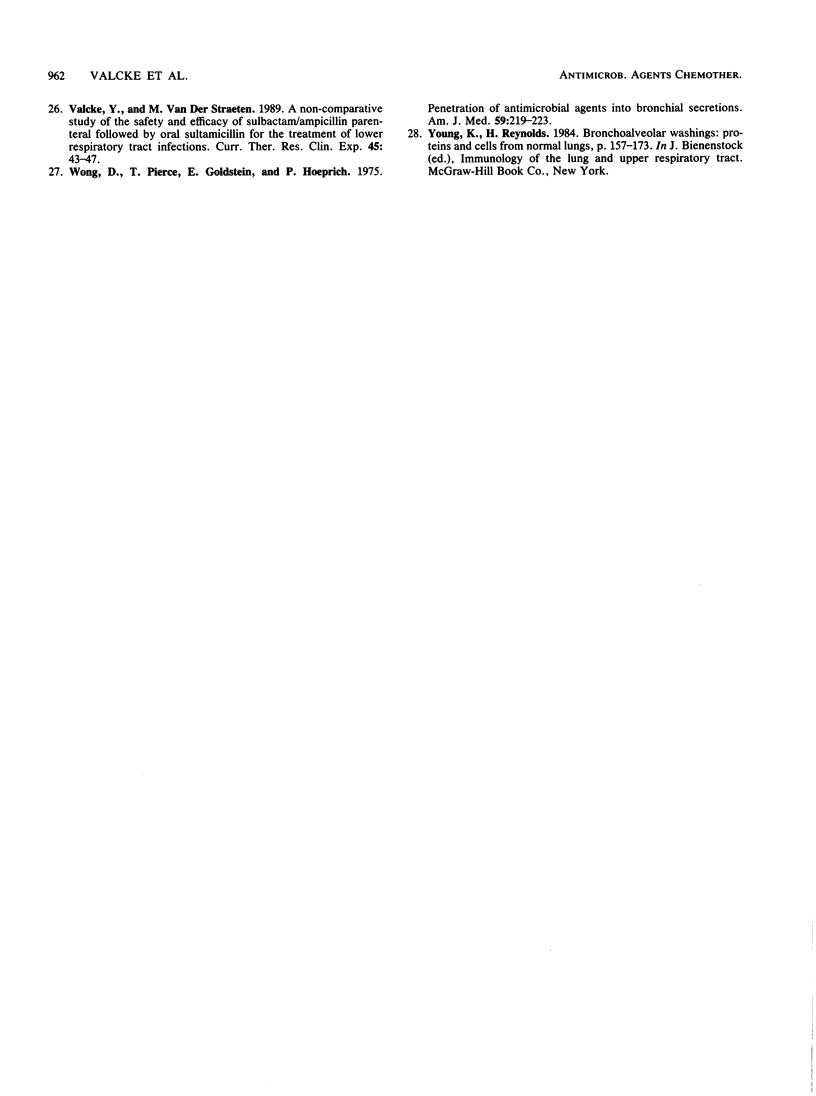
Selected References
These references are in PubMed. This may not be the complete list of references from this article.
- Barza M., Cuchural G. General principles of antibiotic tissue penetration. J Antimicrob Chemother. 1985 Jan;15 (Suppl A):59–75. doi: 10.1093/jac/15.suppl_a.59. [DOI] [PubMed] [Google Scholar]
- Bergogne-Berezin E., Morel C., Benard Y., Berthelot G., Kafe H. Pharmacokinetic study of beta-lactam antibiotics in bronchial secretions. Scand J Infect Dis Suppl. 1978;(14):267–272. [PubMed] [Google Scholar]
- Braude A. C., Cohen R. D., Penner J. L., Preston M. A., Rebuck A. S. Pulmonary disposition of moxalactam. Chest. 1984 Dec;86(6):881–883. doi: 10.1378/chest.86.6.881. [DOI] [PubMed] [Google Scholar]
- Braude A. C., Hornstein A., Klein M., Vas S., Rebuck A. S. Pulmonary disposition of tobramycin. Am Rev Respir Dis. 1983 May;127(5):563–565. doi: 10.1164/arrd.1983.127.5.563. [DOI] [PubMed] [Google Scholar]
- Braude A. C., Rebuck A. S. Pulmonary disposition of cortisol. Ann Intern Med. 1982 Jul;97(1):59–60. doi: 10.7326/0003-4819-97-1-59. [DOI] [PubMed] [Google Scholar]
- Delacroix D. L., Marchandise F. X., Francis C., Sibille Y. Alpha-2-macroglobulin, monomeric and polymeric immunoglobulin A, and immunoglobulin M in bronchoalveolar lavage. Am Rev Respir Dis. 1985 Oct;132(4):829–835. doi: 10.1164/arrd.1985.132.4.829. [DOI] [PubMed] [Google Scholar]
- Friedel H. A., Campoli-Richards D. M., Goa K. L. Sultamicillin. A review of its antibacterial activity, pharmacokinetic properties and therapeutic use. Drugs. 1989 Apr;37(4):491–522. doi: 10.2165/00003495-198937040-00005. [DOI] [PubMed] [Google Scholar]
- Haginaka J., Wakai J., Yasuda H., Uno T., Nakagawa T. High-performance liquid chromatographic assay of sulbactam using pre-column reaction with 1,2,4-triazole. J Chromatogr. 1985 May 31;341(1):115–122. doi: 10.1016/s0378-4347(00)84015-3. [DOI] [PubMed] [Google Scholar]
- Hallett C. J., Cook J. G. Reduced nicotinamide adenine dinucleotide-coupled reaction for emergency blood urea estimation. Clin Chim Acta. 1971 Nov;35(1):33–37. doi: 10.1016/0009-8981(71)90289-0. [DOI] [PubMed] [Google Scholar]
- LeBel M., Spino M. Pulse dosing versus continuous infusion of antibiotics. Pharmacokinetic-pharmacodynamic considerations. Clin Pharmacokinet. 1988 Feb;14(2):71–95. doi: 10.2165/00003088-198814020-00002. [DOI] [PubMed] [Google Scholar]
- MAY J. R., DELVES D. M. TREATMENT OF CHRONIC BRONCHITIS WITH AMPICILLIN: SOME PHARMACOLOGICAL OBSERVATION. Lancet. 1965 May 1;1(7392):929–933. doi: 10.1016/s0140-6736(65)91253-5. [DOI] [PubMed] [Google Scholar]
- Machka K., Braveny I., Dabernat H., Dornbusch K., Van Dyck E., Kayser F. H., Van Klingeren B., Mittermayer H., Perea E., Powell M. Distribution and resistance patterns of Haemophilus influenzae: a European cooperative study. Eur J Clin Microbiol Infect Dis. 1988 Feb;7(1):14–24. doi: 10.1007/BF01962165. [DOI] [PubMed] [Google Scholar]
- Pennington J. E. Penetration of antibiotics into respiratory secretions. Rev Infect Dis. 1981 Jan-Feb;3(1):67–73. doi: 10.1093/clinids/3.1.67. [DOI] [PubMed] [Google Scholar]
- Rebuck A. S., Braude A. C. Assessment of drug disposition in the lung. Drugs. 1984 Dec;28(6):544–553. doi: 10.2165/00003495-198428060-00003. [DOI] [PubMed] [Google Scholar]
- Rennard S. I., Basset G., Lecossier D., O'Donnell K. M., Pinkston P., Martin P. G., Crystal R. G. Estimation of volume of epithelial lining fluid recovered by lavage using urea as marker of dilution. J Appl Physiol (1985) 1986 Feb;60(2):532–538. doi: 10.1152/jappl.1986.60.2.532. [DOI] [PubMed] [Google Scholar]
- Smith B. R., LeFrock J. L. Bronchial tree penetration of antibiotics. Chest. 1983 Jun;83(6):904–908. doi: 10.1378/chest.83.6.904. [DOI] [PubMed] [Google Scholar]
- Stewart S. M., Fisher M., Young J. E., Lutz W. Ampicillin levels in sputum, serum, and saliva. Thorax. 1970 May;25(3):304–311. doi: 10.1136/thx.25.3.304. [DOI] [PMC free article] [PubMed] [Google Scholar]
- Stobberingh E. E., Davies B. I., van Boven C. P. Branhamella catarrhalis: antibiotic sensitivities and beta-lactamases. J Antimicrob Chemother. 1984 Jan;13(1):55–64. doi: 10.1093/jac/13.1.55. [DOI] [PubMed] [Google Scholar]
- Wong G. A., Pierce T. H., Goldstein E., Hoeprich P. D. Penetration of antimicrobial agents into bronchial secretions. Am J Med. 1975 Aug;59(2):219–223. doi: 10.1016/0002-9343(75)90356-3. [DOI] [PubMed] [Google Scholar]


